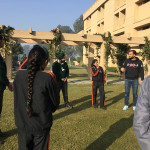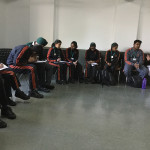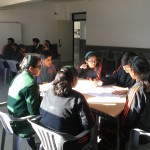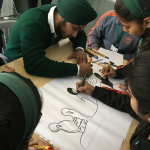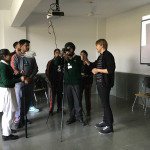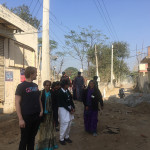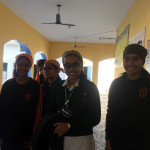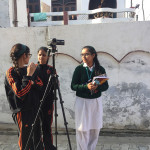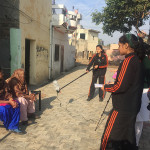Conceived by Barry Van Driel of the Anne Frank House, Memory Walk is a project that functions as an education toolkit to critically look at memorialization, its function, its politics and its relevance today. The project involves students conducting research into local monuments and translating their insights and interviews with the general public, into short films.
For some time now we have wanted to bring the project to India. We were genuinely delighted when Takshila Educational Society decided to support this project and make it possible for Aaron Peterer and Yan Paul Dubbelman—Anne Frank House trainers—to travel to India to conduct this workshop.
The concept of memorialization in the West is quite different from that in the subcontinent and this made Aaron and Yan Paul a bit nervous despite having the experience of conducting this project in several countries across the world.
For us at PeaceWorks, it was special to launch this project in Punjab, a state where the presence of absences in the culture of memorializing and commemorating is perhaps most acute. Through our History for Peace project we have been working on Partition and the absence of the topic in our education system. So it seemed more than appropriate to begin the project in Punjab.
Easier said than done—what were we going to work with! My initial research took me virtually to Mughal Sarai, Doraha built in the 17th century by the Mughal Emperor Sher Shah Suri; a Clock Tower; Sukhdev’s ancestral house, the famous revolutionary who sacrificed his life for the liberty of his country.
But none of these would work, keeping in mind the aims of the project.
So the only way to find information that would be appropriate was to talk to historian friends. A few conversations and some reading later I chanced upon Ajay Bhardwaj’s research that talked about Maseet Wala Gurdwara (literally the mosque turned gurdwara) and Sufi saint shrines which are being looked after the Sikh community in a village called Akalgarh near Ludhiana.
Knowing this information could be hit or miss, we also decided to explore the concept of Memorialization through Music. Our subject would be the young Dalit singer Ginni Mahi and her protest music that talks about atrocities on her community.
To our utter delight we found Akalgarh and Ginni Mahi’s contact. Ginni was travelling so she could not be interviewed, but we had the subjects for the workshop!
Day 1 began with Aaron doing an ice breaker which compelled the participants to show us their best dance moves. This was also exercise in memorizing because each one had to remember all others’ dance moves and names.
The rest of the morning was spent on understanding concepts of monuments, memory and exploring what the participants would consider an ideal monument. Charts were made to depict the ‘idea’ of an ideal monument.
Post lunch was dedicated to ‘Memory Walk’. The entire group visited the communities/areas that were identified as location for interviews and filming. Interestingly, these locations were nothing like places the participants were familiar with, despite being a few kilometers away from their homes.
Akalgarh turned out to be a treasure trove. We found all that Ajay Bhardwaj talks about in his book, and more! The entire group had a thousand questions and the villagers were more than happy to answer them. Why did the mosque turn into a Sikh place of worship? When did this happen? How did this happen? Why is the sufi saint shrine popular today? Who maintains it? Why? It was difficult to get the students to start the journey back from there.
Day 2 began by analyzing the previous afternoon’s visit, the findings and brainstorming in two groups how the material discovered could be turned into a storyboard for a five minute film. Aaron and Yan Paul took charge of one group each. The format, they told the students, had to be interviews with people in the community. Both the groups were asked to formulate three questions that they could ask their interviewees and these three questions needed to reflect the historical issue and its relevance today.
Sounded extremely difficult to me, but by lunchtime both groups had full control of the concepts and were ready with their questions.
Some intense technical tips on handling of camera, sound etc we headed back to the locations we had visited the previous afternoon. This time in two groups—one working on the Partition and the other on Dalits.
Most people interviewed in the Dalit community were not familiar with Ginni Mahi although they had heard her songs. All unanimously agreed that what she was doing was very worthwhile.
The group that was working on Partition had a more difficult task. To begin with two of their interviewees were over 100 years old. First hand experience of the partition but given their age, not easy to communicate with. Nevertheless they captured, on camera, the story behind the mosque turned Gurdwara. They learnt the history of the shrines and recorded interviews of caretakers of the place who are completely unaffected by the difference in religion and consider the space their own. Satiated with knowledge of the past of the village, by sunset we were ready to call it a day.
Day 3 was entirely devoted to editing the films. Completely novice students, under the expert guidance of Aaron and Yan Paul, learnt how to work effectively as a team to edit 20 minute footage into a five minute film with a strong message.
We ended the workshop by presenting the two new Memory Walk films that came out of the workshop.
[ For details of the Memory Walk project in Patna, click here]
– Meena Malhotra

